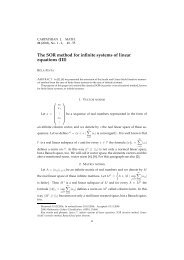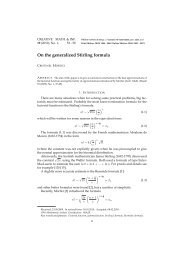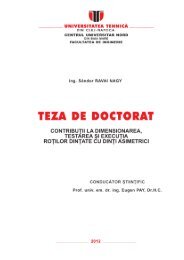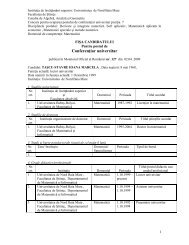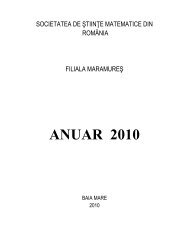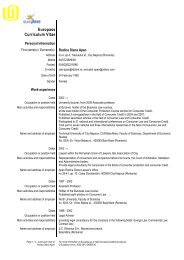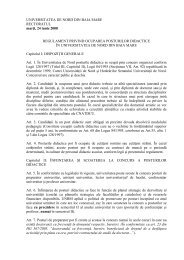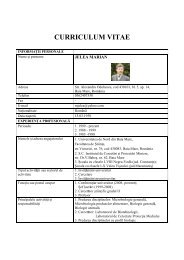Vol 3 (1) 2011 - UBM :: Departamentul de Chimie-Biologie
Vol 3 (1) 2011 - UBM :: Departamentul de Chimie-Biologie
Vol 3 (1) 2011 - UBM :: Departamentul de Chimie-Biologie
Create successful ePaper yourself
Turn your PDF publications into a flip-book with our unique Google optimized e-Paper software.
Carpathian Journal of Food Science and Technology <strong>2011</strong>, 3(1), 63-71<br />
crushed by hand, and their pulps were<br />
removed from seeds. The seeds were<br />
washed with water and left to air-dry for 3<br />
days. Then, the seeds were dried in<br />
atmospheric conditions. The seeds were<br />
comminuted into pieces including a<br />
previously cleaned. The dried materials were<br />
finely ground in a mortar, and the seed<br />
pieces were then stored in an air-tight<br />
container in a refrigerator (-20°C) prior to<br />
analysis.<br />
2.2. Reagents<br />
Petroleum ether (40-60 o C) was of<br />
analytical gra<strong>de</strong> (>98%; Merck, Darmstadt,<br />
Germany). Heptane and tert-butyl methyl<br />
ether were of HPLC gra<strong>de</strong> (Merck,<br />
Darmstadt, Germany). Tocopherol and<br />
tocotrienol standard compounds were<br />
purchased from CalBiochem (Darmstadt,<br />
Germany).<br />
2.3. Oil extraction<br />
Grape seed oil was obtained by<br />
extraction of the meal with petroleum ether<br />
(50 o C) in a Soxhlet extractor for 6 h. After<br />
extraction of the oil, the solvent was<br />
evaporated un<strong>de</strong>r reduced pressure. The<br />
obtained oil was kept in sealed glass bottles<br />
un<strong>de</strong>r <strong>de</strong>ep freezing (-18 o C) for further<br />
analysis.<br />
2.4. Fatty Acid Composition<br />
The fatty acid composition was<br />
<strong>de</strong>termined following the ISO standard ISO<br />
5509:2000 (ISO 2000). In brief, one drop of<br />
the oil was dissolved in 1 mL of n-heptane,<br />
50 µg of sodium methylate was ad<strong>de</strong>d, and<br />
the closed tube was agitated vigorously for 1<br />
min at room temperature. After addition of<br />
100 µL of water, the tube was centrifuged at<br />
4500 g for 10 min and the lower aqueous<br />
phase was removed. Then 50 µL of HCl (1<br />
mol with methyl orange) was ad<strong>de</strong>d, the<br />
solution was shortly mixed, and the lower<br />
aqueous phase was rejected. About 20 mg of<br />
sodium hydrogen sulphate (monohydrate,<br />
extra pure; Merck, Darmstadt, Germany)<br />
was ad<strong>de</strong>d, and after centrifugation at 4500<br />
g for 10 min, the top n-heptane phase was<br />
transferred to a vial and injected in a Varian<br />
5890 gas chromotograph with a capillary<br />
column, CP-Sil 88 (100 m long, 0.25 mm<br />
ID, film thickness 0.2 µm). The temperature<br />
program was as follows: from 155 °C;<br />
heated to 220 °C (1.5 o C/min), 10 min<br />
isotherm; injector 250°C, <strong>de</strong>tector 250°C;<br />
carrier gas 36 cm/s hydrogen; split ratio<br />
1:50; <strong>de</strong>tector gas 30 mL/min hydrogen; 300<br />
mL/min air and 30 mL/min nitrogen; manual<br />
injection volume less than 1 µL. The peak<br />
areas were computed by the integration<br />
software, and percentages of fatty acid<br />
methyl esters (FAME) were obtained as<br />
weight percent by direct internal<br />
normalization.<br />
2.5. Tocopherols<br />
For <strong>de</strong>termination of tocopherols, a<br />
solution of 250 mg of oil in 25 mL of n-<br />
heptane was directly used for the HPLC. The<br />
HPLC analysis was conducted using a<br />
Merck-Hitachi low-pressure gradient<br />
system, fitted with a L-6000 pump, a Merck-<br />
Hitachi F-1000 fluorescence<br />
spectrophotometer (<strong>de</strong>tector wavelengths for<br />
excitation 295 nm, for emission 330 nm),<br />
and a D-2500 integration system. The<br />
samples in the amount of 20 µL were<br />
injected by a Merck 655-A40 autosampler<br />
on to a Diol phase HPLC column 25 cm x<br />
4.6 mmID (Merck, Darmstadt, Germany)<br />
used with a flow rate of 1.3 mL/min. The<br />
mobile phase used was n-heptane/tert-butyl<br />
methyl ether (99+1, v/v [9].<br />
Each method was carried out in<br />
triplicate for each sample. The mean values<br />
were given in the tables, without the<br />
standard <strong>de</strong>viation, because this value would<br />
represent only the <strong>de</strong>viation of the method<br />
and not the variation of the appropriate<br />
sample.<br />
64



